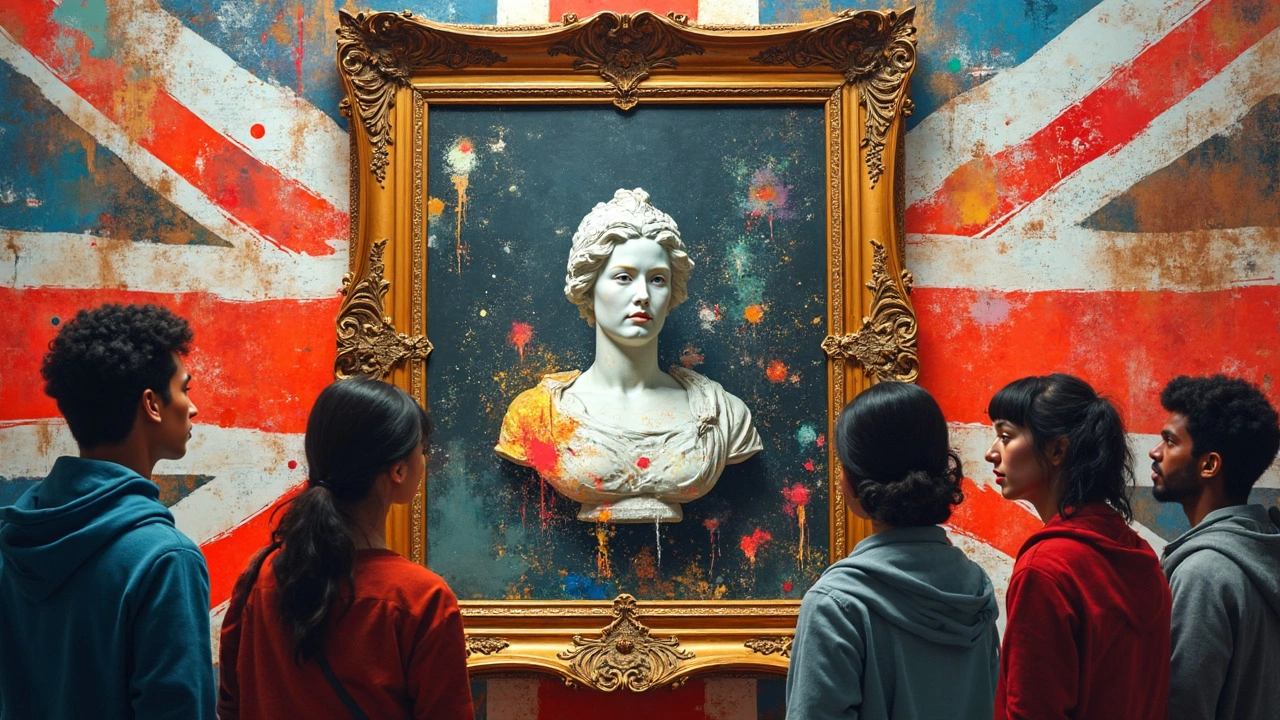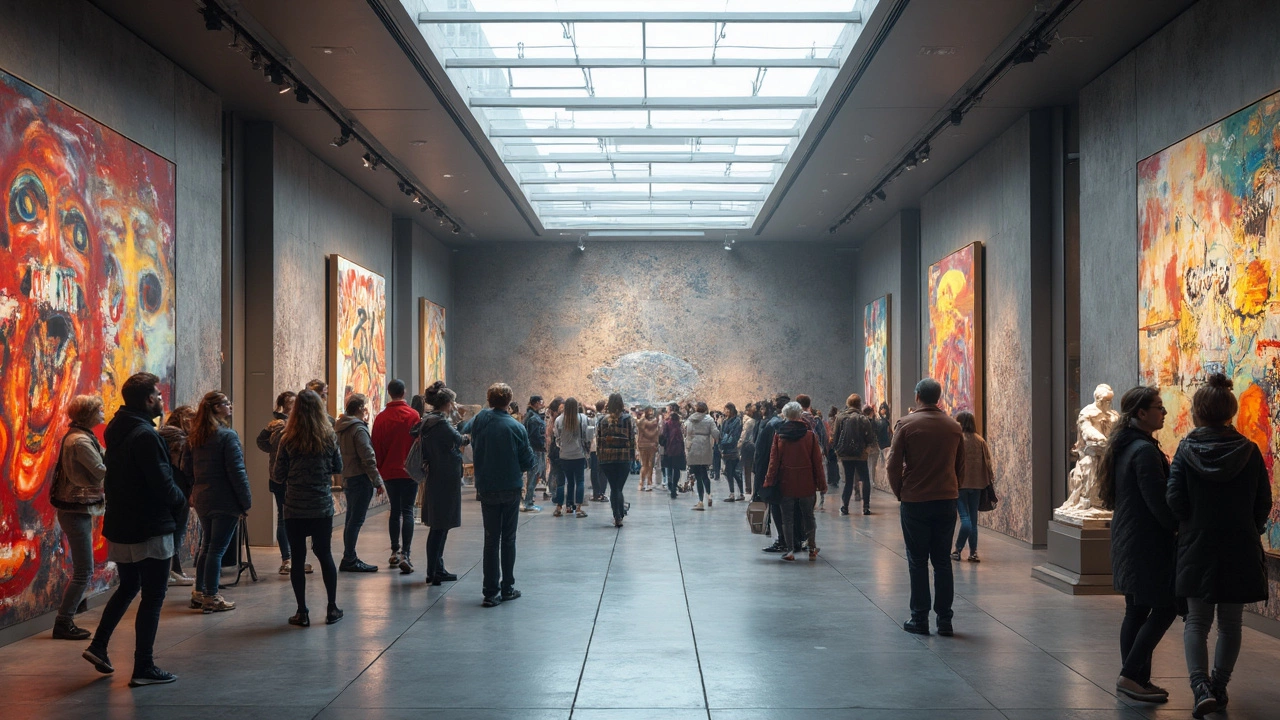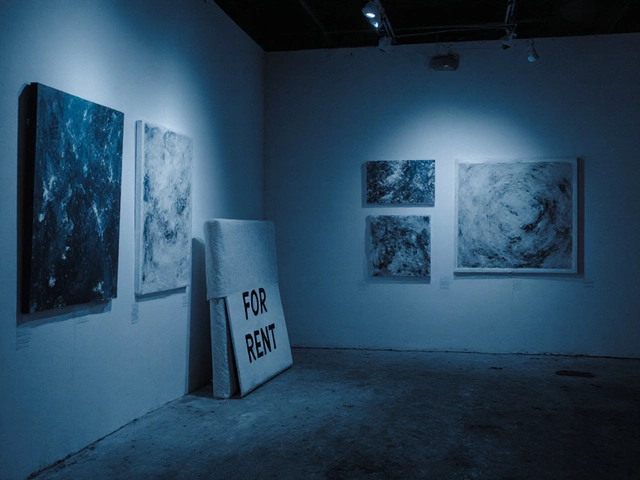If you walk into a gallery today, you’ll see works called both 'contemporary art' and 'fine art.' It sounds like the same thing, right? But even though they overlap sometimes, these words actually mean different stuff.
Fine art covers things like painting, sculpture, and drawing—and the idea is it’s made just for enjoying, not for practical use. Think oil paintings in museums, those big stone statues, or a delicate charcoal portrait. For ages, these were the kinds of art that got all the respect from critics and collectors.
Contemporary art is the new kid on the block. It’s not tied to one style or technique. We're talking everything from videos shot on phones to giant installations that take over whole buildings, or street art that pushes the rules. What matters most is that it’s created by today’s artists and reflects what’s happening now.
People often mix these terms up, especially since some contemporary artists also make paintings and sculptures—classic fine art stuff. Here’s the thing: every piece of contemporary art is made in our time, but not every piece follows the old rules that fine art once set. Think of it kind of like comparing classical music to new experimental beats—both are music, but the attitude and approach are wildly different.
- What Counts as Fine Art?
- Contemporary Art: What Makes It Different?
- Why the Confusion?
- Spotting the Differences: Tips
What Counts as Fine Art?
When people talk about "fine art," they usually mean stuff like paintings, sculptures, prints, and drawings—the kinds of things you spot in famous museums or traditional art classes. Fine art is all about being made for the sake of beauty or pure expression, not for a practical job like a mug or a chair.
Paintings are the big one here. You’ve got oil on canvas, watercolor, and even big, flashy murals that stick around for centuries. Then there’s sculpture—think classic marble statues and modern metal shapes. Drawing and printmaking also fit right in, with artists using pencils, ink, or old-school printing presses to create unique images.
Here’s a quick look at what usually gets called fine art:
- Paintings (oil, acrylic, watercolor, etc.)
- Sculptures (bronze, marble, clay, metal)
- Drawings (charcoal, ink, pencil)
- Printmaking (lithographs, etchings, woodcuts)
- Photography (sometimes included, if done in a "fine art" way)
A big deal about fine art is that it’s often tied to strict training and history. Art schools, like the Royal Academy in London or the École des Beaux-Arts in Paris, have been teaching these classic skills for generations. Most of the time, what you see in these big institutions falls under the fine art label.
“Fine art is that in which the hand, the head, and the heart of man go together.” – John Ruskin
Here’s the thing: fine art is usually about tradition and status. It’s a sign of skill and, sometimes, of what’s seen as "high culture." Some experts crunch numbers on how fine art stacks up in terms of money and reputation. Check this out:
| Art Form | Average Auction Price (USD) | Most Seen In |
|---|---|---|
| Painting | $100,000+ | Museums, private collections |
| Sculpture | $40,000+ | Public squares, museums |
| Printmaking | $10,000+ | Galleries, art fairs |
If you want to spot fine art in the wild, look for polished pieces with attention to detail, strong technical skill, and a nod to historic art movements. These pieces are usually about building on the past, even if the artist adds their personal twist.
Contemporary Art: What Makes It Different?
Contemporary art is anything but predictable. It goes way beyond oil paintings and marble statues. Instead, it’s all about what’s happening right now in our world—new materials, fresh ideas, and conversations nobody had fifty years ago. If you see neon lights stuck to a wall or a sculpture made from old car parts, you’re probably looking at contemporary art.
The first big thing to know? It doesn’t stick to strict rules or a certain look. Modern artists work with anything—spray paint, digital screens, everyday objects, or even social media. You’ll spot a collage mixing newspaper clippings and sneakers in one gallery, and next door, a room-sized video projection commenting on climate change.
Contemporary art is also way more focused on real issues and personal stories. Instead of just showing off technique, it often tackles politics, technology, pop culture, or identity. Artists like Banksy make street art that’s basically social commentary in picture form. Others, like Yayoi Kusama, build entire installations you can walk into, turning art into a full-on experience instead of something you just look at.
Another difference? With contemporary art, anyone can join in. You don’t have to be a graduate from a famous art academy. Many well-known contemporary artists, such as Jean-Michel Basquiat, started out on the streets or with no formal training but ended up celebrated by major museums.
Here’s a tip: if you see something in a gallery that seems weird, interactive, or made out of unexpected stuff, chances are, it fits this contemporary art category. It’s a space for breaking the old rules and asking questions—sometimes more than it answers!

Why the Confusion?
Things get mixed up because the line between contemporary art and fine art is blurred more than ever. For starters, a lot of what you see in galleries or on Instagram gets labeled as both, and nobody hands you a rulebook. Even some art critics can’t agree on strict definitions.
The history adds to the mess. Back in the day, 'fine art' just meant the classics—painting, sculpture, stuff you’d see in old European museums. But in the 1900s, artists started breaking rules. Abstract paintings hit the scene, then pop art, then conceptual art, and suddenly anything could be art if the artist said so. Now, the art world uses 'fine art' to talk about both old masters and newer works that fit traditional categories. That’s tricky, right?
Another reason is money and status. Auction houses and galleries often slap the term 'fine art' on contemporary works to make them seem more valuable. This isn’t just a marketing move—it affects how people and institutions treat the piece. Check out how often contemporary pieces sell alongside classic fine art at big auction houses:
| Year | Contemporary Art Sales ($ Billion) | Fine Art Sales ($ Billion) |
|---|---|---|
| 2022 | 2.7 | 12.9 |
| 2023 | 3.1 | 13.2 |
To make things more confusing, art schools don’t always separate the two when teaching techniques or history. You might find yourself learning about Da Vinci one day and Ai Weiwei the next.
Even online, search engines and social platforms shuffle works from different times and styles together under similar buzzwords, so the more you browse, the harder it gets to draw a clear line.
Spotting the Differences: Tips
It’s way easier to get mixed up between contemporary art and fine art than you’d think. But once you know what to look for, telling them apart can be simple. Here’s how you can spot the difference next time you walk through a gallery or scroll your feed.
- Check the Date: Fine art can be centuries old, while contemporary art is made by current artists—usually from the 1960s onwards. If you see something created before that, it’s probably classic fine art territory.
- Look at the Medium: Fine art sticks with painting, traditional sculpture, or drawing. If the work uses digital tech, video, neon, or even live performance, it probably falls into the contemporary art camp.
- Ask About the Message: Fine art might focus on beauty, skill, or classic scenes. Contemporary art often gets idea-driven, commenting on pop culture, tech, identity, or politics.
- Gallery or Space: Museums with marble floors and gold frames mostly hang fine art, while industrial spaces, street corners, or even parking lots might host contemporary exhibitions.
If you’re still unsure, check out the labels or ask a curator—most will say right out if something is contemporary. The art market also has a clear split: in 2024, contemporary art sales made up about 15% of global auction totals, according to Art Basel’s annual report.
| Feature | Fine Art | Contemporary Art |
|---|---|---|
| Main Mediums | Painting, Sculpture, Drawing | Anything goes: video, digital, installation, street art |
| Date Created | Before 1960s | 1960s-present |
| Main Focus | Skill, Beauty, Craft | Ideas, Social issues, Experimentation |
| Common Spaces | Museums, Galleries | Galleries, Public spaces, Online platforms |
If you want to sound like you know your stuff, mention an artist as an example. For fine art, name someone like Monet or Michelangelo. For contemporary art, bring up Banksy or Yayoi Kusama—both break the traditional mold and get people talking.





